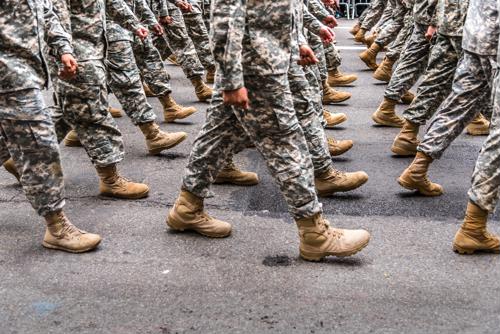
U.S. military continues push for IoT future
By Max BurkhalterMay 30, 2017
Between 2011 and 2015, the U.S military spent more than $2.2 billion on technology associated with the Internet of Things, according to research from the government market analysis research firm Govini. From battlefield-ready sensors to armed autonomous vehicles, the Department of Defense continues to experiment with innovative connected features in an effort to streamline operations, here and abroad, and, more importantly, protect service members navigating combat zones. While drones and other combat equipment are among the most visible examples of this push, the military moves forward with IoT on another more impactful front: logistics.
Bolstering the supply chain
The U.S. military operates possibly the largest and most complex supply chain within the modern industrial realm. Ammunition, fuel and water are its top logistics priorities, as these raw ingredients drive defense operations across the globe, according to the Wharton School of the University of Pennsylvania. The DoD's Defense Logistics Agency is responsible for coordinating the military supply chain, leveraging 27,000 civilian and enlisted staff members to manage roughly 5.2 million items and net nearly $35 billion in annual sales. The group deals with myriad products ranging from food and surgical supplies to pharmaceuticals and weapon systems. Consequently, the DLA executes highly diverse orders that private counterparts such as Amazon or Walmart might not be able to manage.
"The U.S. military operates possibly the largest and most complex supply chain within the modern industrial realm."
On top of this, the DLA works in a uniquely risk-laden environment, as the supplies it shuttles go toward vital ground operations where lives often hang in the balance. Unfortunately, the logistics group and its partners encounter roadblocks often - most recently during the Gulf War and Operation Iraqi Freedom, according to the Harvard Business Review. Over the course of the Gulf War, military supply teams could easily fulfill orders. However, there was little visibility during transit, leading to broken supply lines and mass wastage. In fact, Diane Morales, former deputy undersecretary of U.S. defense for logistics and materiel readiness, estimates that more than 50 percent of the supplies shipped to the Arabian Peninsula during the conflict went unused. The DoD faced similar problems during Operation Iraqi Freedom, as the DLA struggled to stock the fast-moving military units that criss-crossed Iraq.
In the years since these conflicts have come to a close, the DoD has used IoT technology to address the logistics issues each posed. To start, the department attached radio frequency identification tags to all outbound shipments to facilitate improved supply chain transparency. It also outfitted forward-operating military units with sensors so that logistics teams could easily pinpoint their locations and deliver the proper material, on time. The DoD is also testing out the same sensor technology on physical assets, according to the Wharton School. For instance, aircraft in the Joint Strike Fighter program, a collaboration with Boeing and Lockheed Martin, are equipped with sensors that actually monitor internal mechanical and software systems and alert vendors when repairs are needed. This streamlines the shipping and fulfillment process, as parts providers can field work orders and initiate logistics support without human intervention.
Now, the DLA and other military logistics groups can monitor the supply chain with ease and ensure that American combat personnel have the supplies they need - all thanks to IoT technology.
Future IoT opportunities
While the U.S. military has shown itself to be an IoT innovator in the logistics arena, the institution has considerable room to grow in ancillary areas. Where? For one, the technology has the potential to transform its facilities management practices, according to Deloitte. The U.S. military maintains more than 800 bases across the globe, Politico reported. It spends roughly $200 billion per year keeping these facilities in top condition, a Herculean task that requires immense coordination among multiple internal assets. IoT technology could, of course, ease this duty, fostering automated workflows that increase efficiency and cut costs. Large organizations in the private sector have already made headway in this regard by implementing backend IoT systems that regulate interior temperatures and manage lighting fixtures. Some believe the military could take this concept to a new level, implementing mass IoT networks that transform bases into miniature smart cities, according to Wired.
"While the U.S. military has shown itself to be an IoT innovator in the logistics arena, the institution has considerable room to grow."
Metros throughout the U.S. continue to implement large-scale connected structures that improve urban mobility and lead to lower maintenance costs. For example, officials from Columbus, Ohio, winner of the Department of Transportation's Smart City challenge, submitted plans for massive data-based backend systems that would do everything from monitoring traffic patterns to tracking infant mortality rates. This kind of implementation would certainly benefit the U.S. military, which supports more than 1.2 million service members stationed around the world.
With these developments in play and others on the horizon, the DoD looks poised to integrate more IoT technology into its operations. Last year, the agency published its first piece of official guidance on the subject, indicating that further adoption is most likely forthcoming. Perle will be there to offer assistance as the department streamlines its support processes with the latest IoT technology. Our Ethernet extenders, media converters and terminal servers already underpin key connective frameworks within the DoD and its branches. Connect with us today learn more about our work in the defense sector.



